Popular and consistently productive Impala potato variety from Dutch breeders
Early potato varieties are popular among large farmers and summer residents. The Dutch Impala variety meets this requirement and is characterized by high productivity and the ability to adapt to any climate and soil type. The tubers have an attractive appearance and contain an optimal percentage of starch, which allows them to be used for boiling, frying, baking and stewing.
Origin and description of the variety
Early ripening Impala potatoes are a product of breeding work by Dutch biologists Agrico U.A. The crops were added to the State Register of Russia in 1995.
Patent holders: Federal State Budgetary Institution "Kamchatka Research Institute of Agriculture", CJSC "Oktyabrskoye", LLC "Alchak", Federal State Budgetary Institution "Federal Research Center "Kazan Scientific Center of the Russian Academy of Sciences", LLC FH "SeDeK" and other companies.
Pictured are Impala potatoes.

The characteristics of the plant are presented in the table.
| Indicators | Characteristic |
| Ripening period | 40–60 days |
| Bush | Tall, erect, leafy |
| Number of tubers in a bush | 10–12 |
| Weight | 88–150 g |
| Form | Oval |
| Coloring | The skin is yellow with small eyes, the flesh is light yellow |
| Leaves | Medium size, green |
| Corolla color | White |
| Starch content | 10–14% |
| Taste | Excellent (4 on a five-point scale) |
| Cooking class/group | A/B (weak and medium crumbly) |
| Productivity | 180–360 c/ha |
| Marketability | 89–94% |
| Keeping quality | 90% |
| Purpose | Dining room |
| Sustainability | To cancer, potato nematode, viruses, common scab |
| Transportability | High |
How to grow a variety
Impala potatoes are grown in light, slightly moist soils with a moderate amount of nitrogen. The variety's agricultural technology is standard: moderate watering, loosening, weeding, hilling and fertilizing with organic matter and minerals.
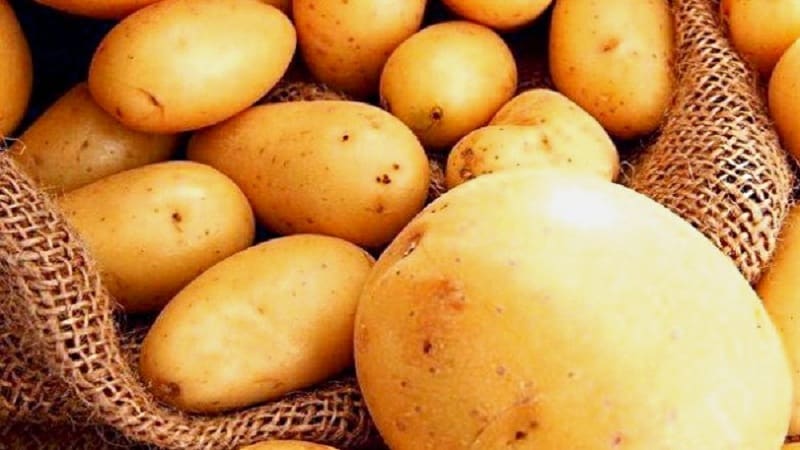
Dates, scheme and rules of planting
Planting material does not need to be germinated before being planted in the ground., but such a procedure promotes the rapid formation of sprouts. To do this, the tubers are taken out of the cellar, seeds with signs of rot are discarded and laid out in an even layer in a bright room. The air temperature for the first week should be +18…+25°С, then +12…+15°С.
The area for planting has been prepared since the fall: dig up and fertilize with manure. In spring, the soil is loosened and holes are formed. Work begins in the second ten days of April or early May, after waiting for the soil to warm up to +7°C. For rapid development of the root system and tubers, the optimal air temperature is +22...+25°C. The growth of tubers stops in heat (from +25°C) or light frosts (–2…–3°C).
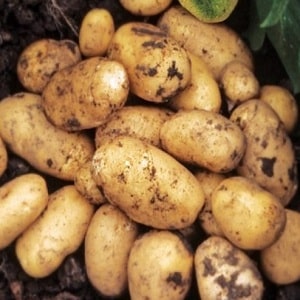 For planting, medium-sized seeds with many eyes are used.. First, the tubers are soaked for 30 minutes in a weak solution of potassium permanganate or boric acid and dusted with ash to reduce the risk of fungal infection. To stimulate growth, use "Epin" or "Zircon".
For planting, medium-sized seeds with many eyes are used.. First, the tubers are soaked for 30 minutes in a weak solution of potassium permanganate or boric acid and dusted with ash to reduce the risk of fungal infection. To stimulate growth, use "Epin" or "Zircon".
Seedlings try not to break off, as this slows down the development of the plant and reduces productivity. The depth of planting potatoes is 6–8 cm with an interval of 30 cm. The distance between rows is 50 cm.
The furrows are located in the direction from north to south. In this way, it is possible to achieve maximum illumination of the plantings.
Reference. Impala potatoes are resistant to damage and retain up to 98% of the fruit's marketable appearance due to its dense skin.
Care
Rules of care:
- Crop rotation. Potatoes cannot be planted every year in the same place or in areas where tomatoes, eggplants, and peppers grew. The best predecessors are wheat, rye, oats, beans, lupine, peas, rapeseed, mustard, and sweet clover.
- Watering. Water consumption per 1 m² - 40 l. In moderate weather, it is enough to water once every 10–12 days. During drought, the frequency of watering is increased and sprinkling is done.
- Loosening. The procedure is carried out without fail, shallowly, trying not to touch the roots and tubers.
- Hilling. The first time is carried out for bushes 20 cm tall, and after flowering it is repeated.
- Mulching. This procedure is optional, but it reduces the evaporation of moisture from the soil, stops the growth of weeds, and eliminates frequent weeding. For this purpose, black agrofibre, hay, straw, sawdust, and peat are used.

Plants are fertilized three times over the entire season according to the following scheme::
- at the beginning of the growing season, apply 1 tsp under the bush. ammonium nitrate, 300 g of humus per 1 bush or mullein infusion (1:10);
- during budding, add 50 g of ash, 10 g of potassium sulfate per 1 bush;
- after flowering (foliar feeding) - 30 g of superphosphate, 200 g of mullein/10 l of water.
Other potato varieties and hybrids:
Mid-early table potatoes "Gourmet" purple
Nuances of cultivation and possible difficulties
Potato Impala grown using Dutch technology, allowing you to get maximum yield with minimal labor costs. Its essence lies in the complete abandonment of beds with holes in favor of long furrows.
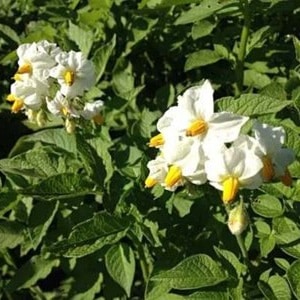 Benefits of technology:
Benefits of technology:
- Tubers are buried to a depth of 15 cm to ensure free access of oxygen to the roots.
- Moisture does not accumulate in the soil and the rhizome does not rot.
- Plants receive a sufficient amount of ultraviolet radiation, and this has a positive effect on productivity.
- The yield from one bush reaches 2 kg of selected tubers.
Landing rules:
- Seeds are planted in the furrows immediately after preparing the soil, preventing it from drying out.
- 6–8 tubers are planted per 1 m² with their sprouts facing up.
- Fertilizers (humus, ash) are placed at the bottom of the furrows, and tubers are placed on top.
- The width between rows is 70–80 cm, the gap between bushes is 25–35 cm.
- The first shoots are covered with earth, creating ridges 8–12 cm high. After 30 days, the procedure is repeated, forming elevations of 25–30 cm.
- Herbicides Centurion, Titus, Lazurit are used to control weeds.
- The area is watered three times: before flowering, 10 days after the flowers appear, at the end of flowering. A drip irrigation system will help reduce labor costs.
Diseases and pests
The Impala variety is resistant to cancer, viruses, scab and nematodes, but is susceptible to late blight and rhizoctonia. The table shows the main symptoms of infection, methods of prevention and treatment.
| Disease | Signs | Treatment | Prevention |
| Late blight | Dark spots and white pubescent coating on the leaves, traces of gray rot on the tubers, wilting of the plant. | Spraying with Bordeaux mixture, Ridomil Gold, Oxyx, Bravo. |
|
| Rhizoctoniosis (black tuber scab) | Dark, deep spots, reticular tissue death. | Treatment with “Maxim” and “Quadris” products. |
|

Potato plantings are often affected by pests - spider mites, aphids, cicadas, and Colorado potato beetles. The table shows ways to get rid of pests on the site.
| Pest | Fighting methods |
| Aphid | Spraying with “Aktara”, “Confidor”, “Aktellik”, infusion of elecampane (200 g of dry roots / 10 l of hot water, leave for 3 hours). |
| Spider mite | Spraying with “Vertimek”, “Bikol”, ammonia (60 ml of ammonia, 25 ml of liquid soap/10 l). |
| Cicada | Irrigation of bushes using Movento Energy, Tabu, Akarin, Calypso, Proteus. |
| Colorado beetle | Treatment with fungicides “Aktara”, “Killer”, “Korado”, “Ultor”, infusion of walnut leaves (300 g of dry leaves/10 l of hot water, leave for a week), dusting with corn flour, gypsum, birch ash. |
Collection, storage and use of crops
To obtain two harvests per season The first potatoes are harvested on a cloudy day, and then the bush is replanted in the ground, abundantly moistening the hole with water. When you first dig, the tubers are watery and the taste is mediocre. They improve over 3-4 weeks.
Potatoes are suitable for frying, baking, making salads and soups. When boiled, the tubers do not darken.
Harvest storage rules:
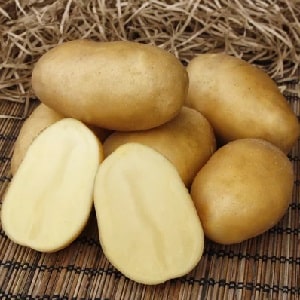 After digging, the tubers are cleared of soil and laid out in a dark place to dry.
After digging, the tubers are cleared of soil and laid out in a dark place to dry.- Fruits are sorted and damaged ones with signs of rot are discarded.
- Potatoes are placed in boxes or bags, beets or apples are placed on top. This proximity prevents germination and rotting.
- On a balcony or loggia with glazing, tubers are stored in thermal containers, boxes insulated with foam plastic or a foil screen.
- The fruits are periodically sorted, completely removed from the storage container. Rotten and green tubers are thrown away.
Advantages and disadvantages
The advantages of the Impala variety include:
- early ripening;
- high yield rates;
- excellent presentation;
- keeping quality;
- excellent taste characteristics;
- widely used in cooking;
- drought resistance;
- resistance to cancer, nematodes, viruses and common scab.
Flaw — tubers crack when there is a lack of moisture.
What regions is it suitable for?
Impala potatoes received permission to grow in Northwestern, Central, Volga-Vyatka, Lower Volga regions. The variety is also successfully cultivated in the south of the country, receiving two harvests per season.
Read also:
Reviews
The Impala variety appeared on the domestic market a long time ago and managed to attract the attention of gardeners and consumers for its excellent taste, early ripening and high yield. Reviews about the variety are mostly positive.
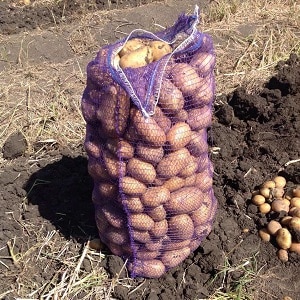 Kirill, Bor: “I have been growing Impala for many years in a row. I really like this variety. The harvest is early, large, the tubers are tasty, they don’t turn into mush. The only disadvantage of the variety is that the potatoes become covered with cracks if there is insufficient moisture. That’s why I installed drip irrigation on the site.”.
Kirill, Bor: “I have been growing Impala for many years in a row. I really like this variety. The harvest is early, large, the tubers are tasty, they don’t turn into mush. The only disadvantage of the variety is that the potatoes become covered with cracks if there is insufficient moisture. That’s why I installed drip irrigation on the site.”.
Anna, Kovrov: “This is one of the most popular potato varieties in our region. Everyone loves it for its early ripeness, high yield and ease of care. It is possible to make two digs. It is stored in the cellar until the summer and does not deteriorate.".
Alexey, Mamonovo: “Impala is one of the best varieties that allows you to get a harvest in just 40 days.The first fruits are a little watery, but if you wait a couple of weeks you can harvest tasty potatoes with optimal starch content. The tubers don’t stop growing until August, so when I dig again, I pull out giant potatoes from the ground.”.
Conclusion
Impala is one of the fastest ripening potato varieties. The crop is valued for its ease of care, adaptation to any climate, and the ability to harvest two crops per season in the southern regions. The variety is ideal for growing young crops and obtaining large tubers of technical ripeness for long-term storage.
The crop is immune to potato canker, viruses, common scab and nematode, but is susceptible to late blight and rhizoctonia. Timely preventive work can prevent infection or reduce losses.